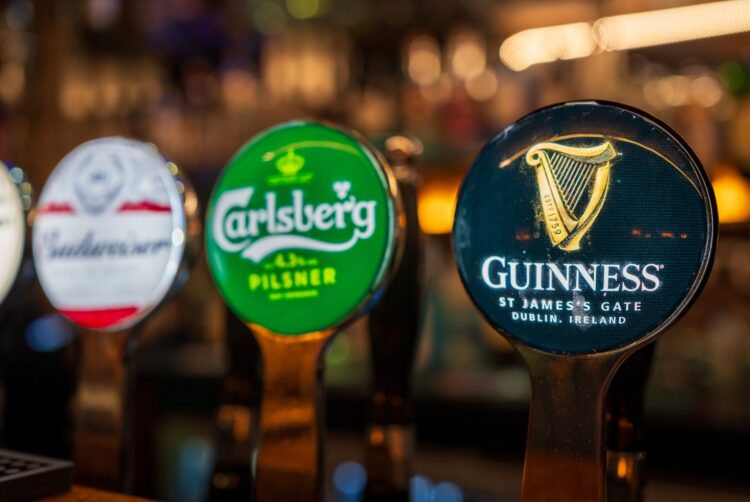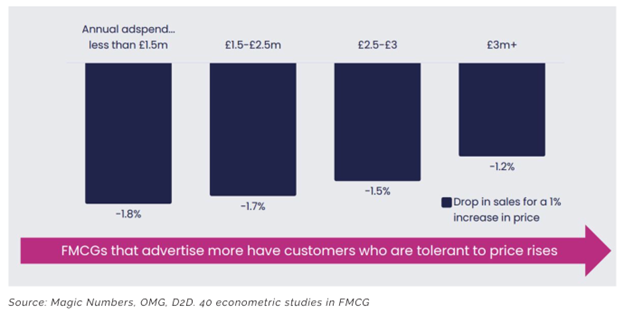Why have I never seen a media brief with pricing power as an objective?

Opinion
We need to recognise pricing as a brand superpower and the role of media within it.
The power of pricing hits me straight in the eye roughly every two weeks, as I queue up for my pre-match pint at the Amex Stadium, home of Brighton & Hove Albion. My pint of Harvey’s costs £5.30, and from memory so do the other beers. Guinness is £5.45.
I spend a lot of time in that queue, and it always makes me curious. Because no-one questions why some beers cost more than others.
Does Guinness cost more to produce than Harvey’s, or more to the point, Heineken? Does it use rare or special ingredients? It’s hardly a niche product. It sells 1.8 billion pints a year and is brewed in 50 countries.
Price is a funny thing. Sometimes you can put the price up and nothing happens, other than you make more profit of course.
When Brighton sold midfielder Moisés Caicedo to Chelsea, something similar happened. The price went up and up and up and the buyer was perfectly happy to cough up. In this case £115m. (In fact, many footballers appear to fall into the category of Veblen goods, a type of luxury good where demand increases with price).
Moment in the sun
I’ve always been attracted by the secret superpower of brands to charge more. It feels intellectually rewarding to think that we can help make a business more profitable through defending a price premium rather than just selling more product. It feels like we’re doing something ingenious.
However, apart from Warren Buffett’s famous admission that “the single most important decision in evaluating a business is pricing power”, it never seemed to gain much traction.
But now it seems that pricing power is finally getting its moment in the sun. The recent period of high inflation generated a lot of data where prices were on the up, and sure enough, the evidence shows that those who spent more on advertising (i.e. invested in their brand) suffered less.

And then we have the recent IPA Effectiveness Grand Prix winning story of McCain oven chips. The paper shows that investing in brand building over nine years helped reduce price elasticity by 47% and rescued McCain Foods from a market that was being commoditised by own-label, in particular by Lidl and Aldi.
In short, people were happy to pay a bit more for a product because it was from a brand that they liked (even loved).
How does media play a role in pricing power?
Kate Waters and her team over at ITV are also doing some interesting work in this area. They point out how far there is to go in making this a more salient topic. Apparently, the McCain example brings the total number of WARC/IPA case studies that mention price elasticity to 13 in the past decade. This from a total of 330.
Mark Ritson’s take on the McCain case study was predictably pithy, but also interesting. Remarkable work, he said, but it’s just applying all the lessons we already know. Nothing new to see here.
I wonder though. What about the role of media in all this? Beyond acknowledging the necessity to invest in “brand-building” media, there is little discussion, debate or understanding about precisely how media plays a role in pricing power.
Media is not just about efficient distribution of an asset. Media is a brand choice. Surely then it really matters where a brand shows up. And this directly impacts price or value perceptions. Furthermore, where you don’t show up is as important as where you do.
It also made me realise something quite startling: I have never seen a media brief with pricing power as an explicit objective.
Why? Perhaps it’s too hard to measure, at least in the short term. And we all know that what gets measured gets managed (and therefore gets into the brief).
Or maybe it’s just less exciting when compared to looking for that dramatic uptick in sales or penetration. Defending market share is a bit like spending your entire career in Health and Safety. The definition of success is that nothing appears to happen.
Reflecting on our work at Electric Glue, maybe we are guilty too for not being more explicit in the role of media in pricing power. Our work with Rightmove over the years directly helped in strengthening their relationship with estate agents, who are their primary source of revenue. Our work with Charlie Bigham’s directly helps defend their price premium versus competitors.
Clearly, we need to recognise pricing as a brand superpower and the role of media within it. And of course, as with all things in our world, principles stay, but practices change. In other words, how to use media to drive pricing power is something that will continue to evolve as the media landscape changes.
‘Premium’ is ubiquitous
One key challenge is that we live in an increasingly premiumised world. From exotic flavoured crisps to budget airlines, from artisan gin to a seat at the cinema, premium is now everywhere. And most media platforms now offer a premium tier.
So maybe it’s less straightforward than it used to be to use a certain media environment to create a premium feel for a brand. Premium is the new normal.
But “premium” can be connoted in different ways. Here are three different expressions of premium, and the takeaways for how we use media to bake them into a brand.
1. Premium as quality
Re-define what quality means for a category. This is what McCain did, by focusing on the quality time with family that oven chips so often deliver, rather than premium taste or premium ingredients.
Think how media could play a role in creating a new context for a brand that celebrates a different aspect of the value that it provides.
2. Premium as leadership
Look outside the category to establish new premium credentials.
See how successful luxury brands now engage in the world of art. Or how premium watch brands show up on the dashboards of prestige and performance cars – at least until they all turned into digital displays. They create a sense of authority and leadership by extending into these new environments.
3. Premium as social
Create new, more intimate relationships between brand and audience.
Just as in the world of music, a brand can have a much more open and authentic conversation with its audience. Media can be used to deepen these relationships and then help people share their experiences with others.
Ultimately, our perceptions of price and value are as emotional as they are rational.
As such, context is everything. As I floated deliriously out of the stadium after Saturday’s victory against Man City to join the long queue for the train, I would have paid a small fortune for that sweet pint of Harvey’s.
 Richard Helyar is chief strategy officer at Electric Glue.
Richard Helyar is chief strategy officer at Electric Glue.




